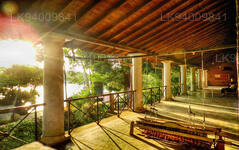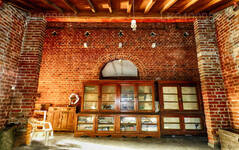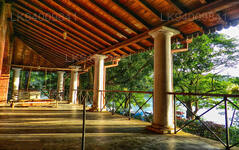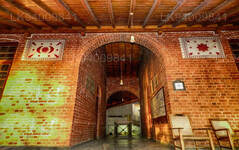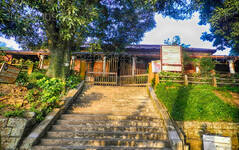
康提是斯里兰卡中部一座风景如画的城市,以其丰富的文化遗产、热闹的节日和优美的景色而闻名。康提坐落在葱郁的群山之中,是联合国教科文组织世界遗产佛牙寺的所在地,将历史与自然的壮丽完美融合,令人叹为观止。
康提是斯里兰卡中部一座风景如画的城市,以其丰富的文化遗产、热闹的节日和优美的景色而闻名。康提坐落在葱郁的群山之中,是联合国教科文组织世界遗产佛牙寺的所在地,将历史与自然的壮丽完美融合,令人叹为观止。
Kandyan Art Association Cultural Centre
Kandyan Art Association is an association formed in 1882 to revitalise traditional Kandyan arts and crafts (such as weaving, wood carving, painting, jewelry making, music and dance) and support the traditional craftsmen by providing them a sales outlet.
Artists and craftsmen in the Kingdom of Kandy were well organised into guilds, with knowledge and skills passed down from generation to generation. Even marriages were within the same group so that the craft was closely guarded. These guilds all operated under the patronage of the king. When the kingdom was absorbed into the British Empire as a protectorate, following the Kandyan Convention of 1815, without a royal household most of these artists and craftsmen lost their livelihood and the guilds were disbanded, with only a few families continuing their crafts.
The association was established in 1882 by the British Government agent for the Central Province, Sir John Frederick Dickson, who brought together the traditional artists and the craftsmen in the Central Province. Initially it operated from a small room in the Government Agent’s Office. In 1904 the Association moved to the building known as the Palle Vahala (Lower Palace), the palace where the king's spouse and children resided. The building now houses the National Museum of Kandy.
In 1919 the association was incorporated as a public trust, and is now administered by the Government Agent of Kandy District and a management committee.
In 1924 the association was relocated to its present location, the former Kunam Maduwa (House of the Palanquins), which housed the palanquins used by the Kandyan royal court. The Kunam Maduwa was built by King Vimaladharmasuriya in the 16th Century. In 1876 the building was converted and used by the British as a military hospital.
In 1982 the association undertook a significant expansion, in conjunction with the organisation's centenary, constructing a new cultural centre and theatre adjoining the existing heritage building. The project was designed by Minnette de Silva, the first Sri Lankan female architect. The building was completed in August 1984, with a central theatre complex that seats 1,500 people, galleries and studio spaces. The theatre was extensively damaged by the 1998 bombing of the Temple of the Tooth by the Liberation Tigers of Tamil Eelam. In 2005 the government, through the efforts of Lakshman Kadirgamar (National List MP and Minister of Foreign Affairs), provided 7 million LKR to restore and enhance the building complex.
The Association organises a daily one hour traditional Kandyan dance and music performance showcase in the building's auditorium. These dances are performed by local families and products of the country's dancing institutions. The sales centre displays and sells handicrafts obtained from traditional crafts people who are members of the association.
关于康提区
康提区位于斯里兰卡中部省份。康提是斯里兰卡七大世界遗产之一,曾是 16 世纪康提国王的故乡,也是该国音乐、艺术、工艺和文化的源泉。康提距离科伦坡约 129 公里,坐落在丘陵地带,所有人的目光都集中在市中心,康提湖在那里形成了一道迷人的风景。康提对斯里兰卡具有重要的宗教意义,因为达拉达·马利加瓦(Dalada Maligawa)就坐落在这个迷人的城市,佛牙寺内安放着佛陀的圣牙舍利,并受到严密保护。佩拉德尼亚皇家植物园位于佩拉德尼亚市中心以西约 5 公里处,每年接待 120 万人次参观,是岛上最大的植物园。乌达瓦塔森林 (Udawatta Kele) 是位于市中心、佛牙寺北面的一处保护区。康提是一座僧伽罗人占多数的城市;也有相当数量的其他族裔社区,如摩尔人和泰米尔人。康提是仅次于科伦坡的斯里兰卡经济中心。许多大型公司在康提设有大型分支机构,纺织、家具、信息技术和珠宝等众多行业都在这里落户。许多农业研究中心都位于该市。康提也是该国所有音乐、艺术、工艺和文化的源头。康提距科伦坡约 129 公里,坐落在丘陵地带,所有人的目光都集中在市中心,康提湖是这里的一道迷人风景。康提对斯里兰卡具有重要的宗教意义,因为佛牙寺就坐落在这座迷人的城市中,佛陀的圣牙舍利就安放在其中,并得到妥善的保护。
关于中央省
斯里兰卡中央省主要由山地构成。该省面积5,674平方公里,人口2,421,148。主要城镇包括康提、甘波拉(24,730)、努沃勒埃利耶和班达拉维拉。人口由僧伽罗人、泰米尔人和摩尔人组成。山地首府康提和努沃勒埃利耶市以及斯里帕达都位于中央省。该省盛产著名的锡兰茶,这种茶由英国人在19世纪60年代一场毁灭性的疾病摧毁了该省所有的咖啡种植园后种植。中央省吸引了众多游客,拥有康提、甘波拉、哈顿和努沃勒埃利耶等山地度假小镇。佛牙寺(Dalada maligawa)是中央省的主要圣地。气候凉爽,海拔1500米左右的许多地区夜晚常常寒冷。西坡非常湿润,有些地方年降雨量接近7000毫米。东坡属于中干旱地区,仅受东北季风影响。气温范围从康提的24°C到海拔1889米的努沃勒埃利耶的16°C。斯里兰卡最高的山脉位于中央省。地形以山地为主,深谷穿插其中。两个主要山区是中央山脉和康提东部的努克尔斯山脉。

